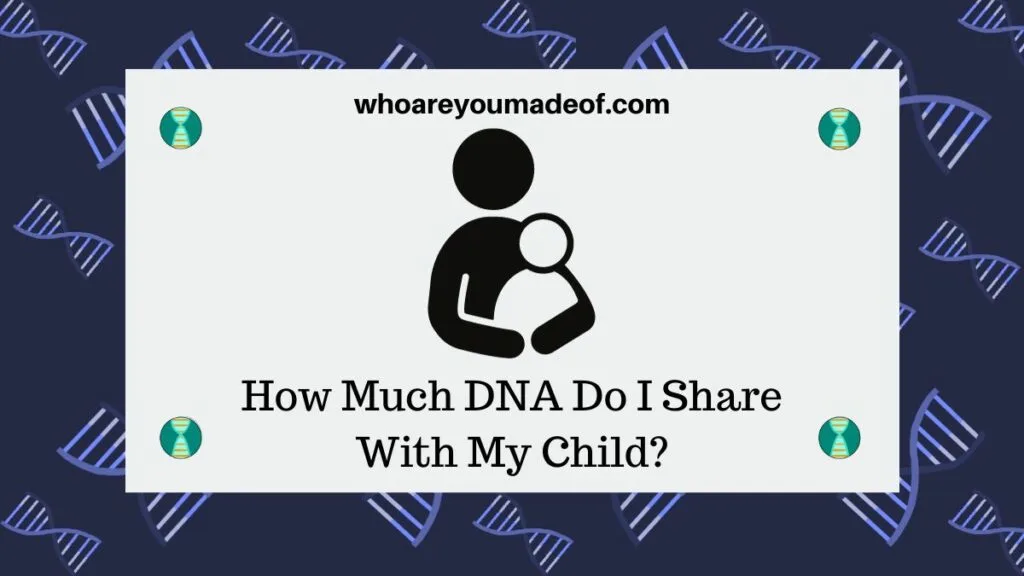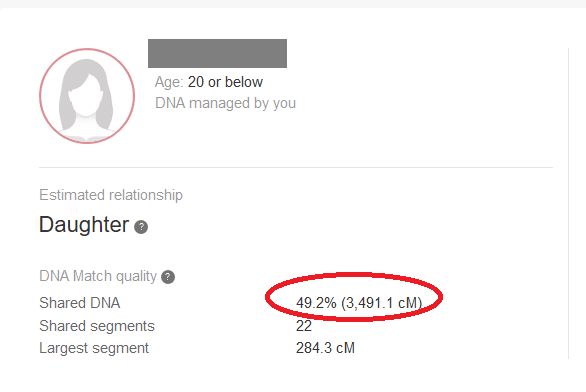In this post, you will learn how much DNA you share with your child and how this affects your child's ethnicity estimate.

If you have done an autosomal DNA test, you might be wondering what the average number of centimorgans (cMs) a parent will share with their child. This is a very common question!
How much DNA do I share with my child?
Your child will share very close to 50% of their DNA with you, which equals around 3400 cMs. The exact amount of DNA (measured in centimorgans or percentages) won't be displayed as this exact amount.
Instead, it will fall within a range, which is generally between about 3300-3700 cMs.
Are you surprised to learn that your offspring will only share 50% of their DNA with you? We don't pass down all of our genes to our children, unfortunately.
Every person has 22 numbered chromosomes and a sex chromosome. Our children inherit 50% of our genes from each chromosome through a process called recombination.
Recombination works something like this: We have two copies of each chromosome which we inherited from each of our parents.
Since we have two copies of each chromosome, the two copies of each chromosomes that we have must "recombine" to form into a "new" chromosome that we can pass down to our kids.
Recombination is necessary because chromosomes are a set size, and are not big enough to hold all of the DNA that our parents (and all of our ancestors). Scientists also believe that recombination is one way that animals, including humans, create genetic diversity.
The end result of this process is that our child will have two copies of each chromosome, too, but only one of their copies is a mixture of your two copies of each chromosome. The other 50% of their DNA (the other copy of their chromosomes) came from their other parent - also a "recombined" copy.
Example of a child DNA match on Ancestry DNA
In the image below, you can see how much DNA I share with my daughter on my Ancestry DNA results. We share 3,465 cMs, which is just about exactly the average of shared autosomal DNA that shows up on these types of tests.
You might also note that Ancestry states clearly that our "predicted relationship" is Parent/Child. Since parents share so much DNA with their children, this type of predicted relationship is rarely wrong.

Example of a child DNA match on My Heritage DNA
This is how the same daughter shows up as a match for me on My Heritage. You will notice that there is a slight difference in the reported shared centimorgans.
We show up as sharing 3,491 cMs on My Heritage, but only share 3,465 cMs on Ancestry DNA. This is only a slight difference and is insignificant as far as determining a relationship - especially since I already know we are parent and child.
The explanation for the variation in shared DNA between companies is due to the algorithm used to determine matches, and the thresholds for SNPs and segment sizes - nothing to stress over.

Is it possible for a child to have more DNA from one parent than the other?
No, your child will inherit 50% of their autosomal DNA from the mother, and 50% from the father. There is no way that inherited significantly more autosomal DNA from one parent.
Even when taking the sex chromosome into consideration, a child shares the same amount of DNA with each parent.
This is because a son inherits an X chromosome from his mother, and a Y chromosome from his father. A daughter inherits an X chromosome from each parent.
This means both our sons and daughters share 50% of our DNA with us, no matter how we look at it.
Sometimes, people are tempted to think that a child shares more DNA with them because of physical traits or personality characteristics that they display. Our genes work in funny ways - traits sometimes show up, and other times they don't.
Occasionally, one of our children may seem more like us than another, but the amount of shared DNA is never more than 50%.
Note: Even though a child does share 50% of their DNA with each parent, there is some evidence that gene expressions tend to favor the dad's genes 🙂
How much of my ethnicity will I pass down to my child?
Because your child only shares 50% of your DNA with you, you can also expect that their ethnicity estimate will not exactly match yours. As I mentioned before, DNA is passed down in a process called recombination.
There is one more important thing you should know about recombination, especially when it comes to ethnicity estimates: it's random.
That's right, when recombination occurs and the "new" copy of the chromosome is made to get passed down to your child, there is no real way to know which DNA will get passed down.
For example, if you have 30% Nigerian DNA, your child might get all of it, none of it, or some of it. The general rule of thumb is that they will get half of it, but this rarely occurs.
It's more likely that they will some Nigerian DNA, and some of your other ethnicity regions.
Can my child have an ethnicity region show up in their results that I don't have?
It is also possible for your child to have an ethnicity show up in their DNA that does not show up in yours. How can this be?
Let's imagine that your child shows some Irish ancestry that didn't show up in their results. There is a chance that their other parent has Irish ancestry, and so you could have their other parent take a DNA test to confirm this.
An additional explanation is that both you and your child's other parent have very small "trace" amounts in your DNA, and your child happened to inherit both of those minute amounts - leading to a detectable amount for their ethnicity estimate.
Conclusion
I hope that this post answered your question about how much DNA you share with your child. Have you found any surprises, either with amount of shared DNA or ethnicity, when testing yourself and/or your parents?
I'd love to hear from you in the comments below.
Thanks for stopping by!


Mary
Sunday 30th of July 2023
I will need to read this several times before I digest all of this. Thanks
Keith Wagner
Wednesday 20th of April 2022
Interesting article. I happened upon your article doing a Google search of why my daughter will show .5% Ashkenazi and I show absolutely none. I thought that since she got half her DNA from me that I would show some Ashkenazi also. Her mothers side of the family are all from Mexico with the exception of one of her fathers stepfather who was Irish we think. Very confusing. Thank you for your article.
Emily Lees
Wednesday 16th of March 2022
Thank you for the article. I am trying to find out how my daughter's DNA test showed she was 40% Ashkenazi Jewish. Her father's family were Jewish from Eastern Europe. So why is she not 50% Ashkenazi? I have read suggest that it is unlikely for Sephardic Jews to have immigrated to Eastern Europe. But what about more recent ancestors? Is it possible that the other 10% of DNA inherited from her father is actually Sephardic (showing up as something besides Jewish)? Perhaps from an American ancestor? Or does this mean that there were some non-Jewish ancestors somewhere in his distant history? Thank you for your help and clarification.
Mercedes
Thursday 17th of March 2022
Hi Emily, Thank you so much for your question. Which company did your daughter do her test with? On some companies (such as Ancestry) you can click on the region and see a range of percentage of their DNA matching that region. In your daughter's case, the range may include a number that is higher than 40%. It is also possible that her father had a more distant ancestor who may not have matched the Ashkenazi Jewish DNA region. Is there a region on her results that doesn't match your results? That might be a good place to start research. However, the best strategy for working this all out will be building her father's family tree. I hope that this helps! Sincerely, Mercedes
james adams
Thursday 26th of August 2021
How much of my DNA would show up in my brothers child?
Mercedes
Friday 27th of August 2021
Hi James, If your brother is a full brother (you share both parents), then you would share an average of about 25% of your DNA with his children, with the actual percentage ranging from between about 18-33%. You can read more about it here: https://whoareyoumadeof.com/blog/how-much-dna-do-you-share-with-an-aunt-or-uncle/
Jason R Porter
Tuesday 17th of August 2021
how many markers